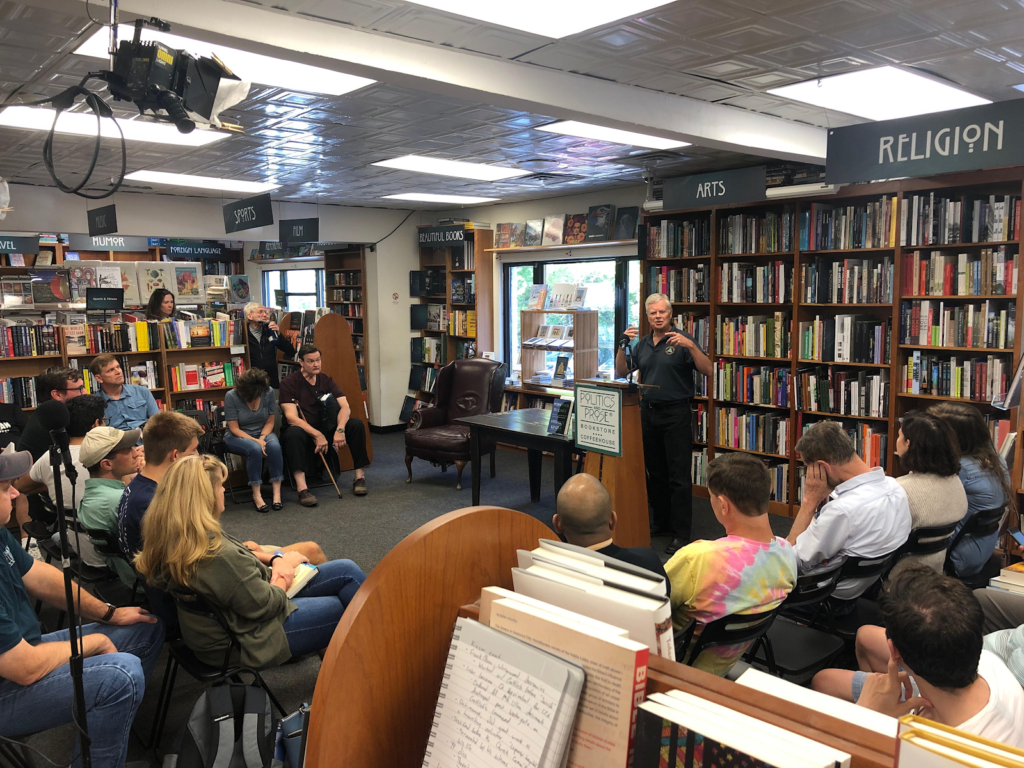Stephen Kinzer Gives Book Talk on ‘Poisoner In Chief’

Author Stephen Kinzer gives a lecture at Politics and Prose on his latest book ‘Poisoner in Chief.’
By Jared Prenda
Magical realism is defined as “a literary or artistic genre in which realistic narrative and naturalistic technique are combined with surreal elements of dream or fantasy.” Upon the first glance of Stephen Kinzer’s book, one might categorize ‘Poisoner In Chief’ under magical realism, with events too absurd to comprehend, but it is entirely nonfiction.
Kinzer came to Politics and Prose on Connecticut Avenue to have a discussion about his 10th book, highlighting the life of Dr. Sidney Gottlieb. Gottlieb was the chief chemist of the CIA and director of the controversial MK-Ultra program from its beginning in 1953 and served as director for 10 years. During his tenure, Gottlieb was responsible for spending $240,000 in order to attain the world’s entire supply of LSD in order to research the possibility of mind control after the CIA feared the Soviets were already capable of such a feat.
Kinzer is one of the most influential foreign policy journalists who served for 20 years covering foreign news for the New York Times. During his tenure with the times, Kinzer sat as the bureau chief for the New York Times offices in Nicaragua from 1983 to 1989, Germany from 1990 to 1996, and in Turkey from 1996 to 2000. His coverage of the political turmoil in Central America and Eastern Europe following the fall of the Soviet Union earned Kinzer multiple awards and recognition. He currently serves as a senior fellow at the Watson Institute of International and Public Affairs at Brown University.
Before the release of the book, little was known of Gottlieb and Kinzer even stated at the beginning of his talk.
“I think I discovered or stumbled across, the most powerful, unknown American of the Twentieth Century. Unless someone else conducted extreme experiments on human subjects across three continents, lived in complete invisibility, and had what amounted to what was the license to kill from the US Government” said Kinzer.
The book shop café, Politics and Prose, was packed with rows of local residents to hear the author speak about his discoveries about the little known director of one of the CIA’s most controversial research projects. The discussion was broken up into two segments with the first half being Kinzer’s outline of his research and discoveries about Gottlieb, who died suspiciously in 1999 before a lawsuit about his research was about to be brought to court. The second half was a Q&A section where many of the attendees bounced their own theories about the fallout of Gottlieb’s work off of the author.
Gottlieb himself was a fascinating character. The son of Hungarian Jewish immigrants, he was one of the first Jews hired by the agency in 1951 at thirty-three-years-old. He was a type of hippy who lived in an eco-home in the woods and would milk his own goats every morning. Following his career in espionage, he went on great mission trips where he’d work in leprosy hospitals in India and perform other works of charity. All the while, he was wreaking havoc on the lives of American citizens and committing war crimes against East Asian prisoners of war deemed “expendables.” As his time as chief chemist, he came up with various ways to administer poison in assassination attempts, particularly on infamous Cuban dictator Fidel Castro and Congolese president Patrice Lumumba.
Throughout the lecture, the journalist outlined horrific stories of research where the CIA used prisoners of war, unknowing American and Canadian citizens, including terminally ill hospital patients with a variety of drugs and torture in order to accomplish the goal of mind control in a two-part process.
“At the end of these 10 years, he came to what amounts to a double conclusion. One, yes it is possible to destroy a person’s mind. He verified this time and time again with his experiments and destroyed countless lives,” Said Kinzer. “Two, it is not possible to insert a new mind into the void you’ve created, and the 10 years of suffering was in vain.”
These research facilities were often unaware of the CIA’s involvement in these experiments. Some of which happened even here in the DMV area at the University of Maryland, George Washington University, and Georgetown University according to a Washington Post article written in 1977 following congressional hearings on the matter. All three universities either denied any knowledge of the experiments or declined to comment.
One particularly horrific tale outlined by Kinzer spoke of seven anonymous African American prisoners in Kentucky, who without consent or permission were isolated in small cells.
The inmates were administered “triple and quadruple doses of LSD for 77 straight days without any idea what they were being given or what might happen” said Kinzler.
The book is for sale on Amazon and Kinzer himself is on a book tour, speaking with NPR and visiting various book shops across the country. One line from the acknowledgments section details the mystery behind both Gottlieb and MK-Ultra, as all documents, including the names of its test subjects, were destroyed on the CIA’s orders.
“Everything in this book is true, but not everything that is true is in this book” wrote Kinzler.







